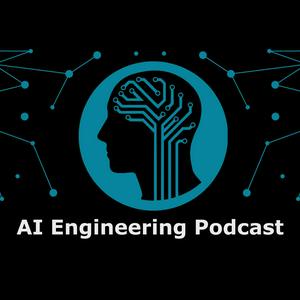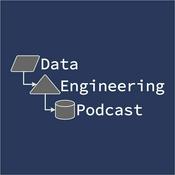Épisodes disponibles
5 sur 71
- Context as Code, DevX as Leverage: Accelerating Software with Multi‑Agent WorkflowsSummary In this episode Max Beauchemin explores how multiplayer, multi‑agent engineering is reshaping individual and team velocity for building data and AI systems. Max shares his journey from Airflow and Superset to going all‑in on AI coding agents, describing a pragmatic “AI‑first reflex” for nearly every task and the emerging role of humans as orchestrators of agents. He digs into shifting bottlenecks — code review, QA, async coordination — and how better DevX/AIX, just‑in‑time context via tools, and structured "context as code" can keep pace with agent‑accelerated execution. He then dives deep into Agor, a new open‑source agent‑orchestration platform: a spatial, multiplayer canvas that manages git worktrees and shared dev environments, enables templated prompts and zone‑based workflows, and exposes an internal MCP so agents can operate the system — and each other. Max discusses session forking, sub‑session trees, scheduling, and safety considerations, and how these capabilities enable parallelization, handoffs across roles, and richer visibility into prompting and cost/usage—pointing to a near future where software engineering centers on orchestrating teams of agents and collaborators. Resources: agor.live (docs, one‑click Codespaces, npm install), Apache Superset, and related MCP/CLI tooling referenced for agent workflows. Announcements Hello and welcome to the AI Engineering Podcast, your guide to the fast-moving world of building scalable and maintainable AI systemsWhen ML teams try to run complex workflows through traditional orchestration tools, they hit walls. Cash App discovered this with their fraud detection models - they needed flexible compute, isolated environments, and seamless data exchange between workflows, but their existing tools couldn't deliver. That's why Cash App rely on Prefect. Now their ML workflows run on whatever infrastructure each model needs across Google Cloud, AWS, and Databricks. Custom packages stay isolated. Model outputs flow seamlessly between workflows. Companies like Whoop and 1Password also trust Prefect for their critical workflows. But Prefect didn't stop there. They just launched FastMCP - production-ready infrastructure for AI tools. You get Prefect's orchestration plus instant OAuth, serverless scaling, and blazing-fast Python execution. Deploy your AI tools once, connect to Claude, Cursor, or any MCP client. No more building auth flows or managing servers. Prefect orchestrates your ML pipeline. FastMCP handles your AI tool infrastructure. See what Prefect and Fast MCP can do for your AI workflows at aiengineeringpodcast.com/prefect today.Unlock the full potential of your AI workloads with a seamless and composable data infrastructure. Bruin is an open source framework that streamlines integration from the command line, allowing you to focus on what matters most - building intelligent systems. Write Python code for your business logic, and let Bruin handle the heavy lifting of data movement, lineage tracking, data quality monitoring, and governance enforcement. With native support for ML/AI workloads, Bruin empowers data teams to deliver faster, more reliable, and scalable AI solutions. Harness Bruin's connectors for hundreds of platforms, including popular machine learning frameworks like TensorFlow and PyTorch. Build end-to-end AI workflows that integrate seamlessly with your existing tech stack. Join the ranks of forward-thinking organizations that are revolutionizing their data engineering with Bruin. Get started today at aiengineeringpodcast.com/bruin, and for dbt Cloud customers, enjoy a $1,000 credit to migrate to Bruin Cloud.Your host is Tobias Macey and today I'm interviewing Maxime Beauchemin about the impact of multi-player multi-agent engineering on individual and team velocity for building better data systemsInterviewIntroductionHow did you get involved in the area of data management?Can you start by giving an overview of the types of work that you are relying on AI development agents for?As you bring agents into the mix for software engineering, what are the bottlenecks that start to show up?In my own experience there are a finite number of agents that I can manage in parallel. How does Agor help to increase that limit?How does making multi-agent management a multi-player experience change the dynamics of how you apply agentic engineering workflows?Contact InfoLinkedInLinksAgorApache AirflowApache SupersetPresetClaude CodeCodexPlaywright MCPTmuxGit WorktreesOpencode.aiGitHub CodespacesOnaThe intro and outro music is from Hitman's Lovesong feat. Paola Graziano by The Freak Fandango Orchestra/CC BY-SA 3.0--------59:49
- Inside the Black Box: Neuron-Level Control and Safer LLMsSummary In this episode of the AI Engineering Podcast Vinay Kumar, founder and CEO of Arya.ai and head of Lexsi Labs, talks about practical strategies for understanding and steering AI systems. He discusses the differences between interpretability and explainability, and why post-hoc methods can be misleading. Vinay shares his approach to tracing relevance through deep networks and LLMs using DL Backtrace, and how interpretability is evolving from an audit tool into a lever for alignment, enabling targeted pruning, fine-tuning, unlearning, and model compression. The conversation covers setting concrete alignment metrics, the gaps in current enterprise practices for complex models, and tailoring explainability artifacts for different stakeholders. Vinay also previews his team's "AlignTune" effort for neuron-level model editing and discusses emerging trends in AI risk, multi-modal complexity, and automated safety agents. He explores when and why teams should invest in interpretability and alignment, how to operationalize findings without overcomplicating evaluation, and the best practices for private, safer LLM endpoints in enterprises, aiming to make advanced AI not just accurate but also acceptable, auditable, and scalable. Announcements Hello and welcome to the AI Engineering Podcast, your guide to the fast-moving world of building scalable and maintainable AI systemsWhen ML teams try to run complex workflows through traditional orchestration tools, they hit walls. Cash App discovered this with their fraud detection models - they needed flexible compute, isolated environments, and seamless data exchange between workflows, but their existing tools couldn't deliver. That's why Cash App rely on Prefect. Now their ML workflows run on whatever infrastructure each model needs across Google Cloud, AWS, and Databricks. Custom packages stay isolated. Model outputs flow seamlessly between workflows. Companies like Whoop and 1Password also trust Prefect for their critical workflows. But Prefect didn't stop there. They just launched FastMCP - production-ready infrastructure for AI tools. You get Prefect's orchestration plus instant OAuth, serverless scaling, and blazing-fast Python execution. Deploy your AI tools once, connect to Claude, Cursor, or any MCP client. No more building auth flows or managing servers. Prefect orchestrates your ML pipeline. FastMCP handles your AI tool infrastructure. See what Prefect and Fast MCP can do for your AI workflows at aiengineeringpodcast.com/prefect today.Unlock the full potential of your AI workloads with a seamless and composable data infrastructure. Bruin is an open source framework that streamlines integration from the command line, allowing you to focus on what matters most - building intelligent systems. Write Python code for your business logic, and let Bruin handle the heavy lifting of data movement, lineage tracking, data quality monitoring, and governance enforcement. With native support for ML/AI workloads, Bruin empowers data teams to deliver faster, more reliable, and scalable AI solutions. Harness Bruin's connectors for hundreds of platforms, including popular machine learning frameworks like TensorFlow and PyTorch. Build end-to-end AI workflows that integrate seamlessly with your existing tech stack. Join the ranks of forward-thinking organizations that are revolutionizing their data engineering with Bruin. Get started today at aiengineeringpodcast.com/bruin, and for dbt Cloud customers, enjoy a $1,000 credit to migrate to Bruin Cloud.Your host is Tobias Macey and today I'm interviewing Vinay Kumar about strategies and tactics for gaining insights into the decisions of your AI systemsInterview IntroductionHow did you get involved in machine learning?Can you start by giving a quick overview of what explainability means in the context of ML/AI?What are the predominant methods used to gain insight into the internal workings of ML/AI models?How does the size and modality of a model influence the technique and evaluation of methods used?What are the contexts in which a team would incorporate explainability into their workflow?How might explainability be used in a live system to provide guardrails or efficiency/accuracy improvements?What are the aspects of model alignment and explainability that are most challenging to implement?What are the supporting systems that are necessary to be able to effectively operationalize the collection and analysis of model reliability and alignment?"Trust", "Reliability", and "Alignment" are all words that seem obvious until you try to define them concretely. What are the ways that teams work through the creation of metrics and evaluation suites to gauge compliance with those goals?What are the most interesting, innovative, or unexpected ways that you have seen explainability methods used in AI systems?What are the most interesting, unexpected, or challenging lessons that you have learned while working on explainability/reliability at AryaXAI?When is evaluation of explainability overkill?What do you have planned for the future of AryaXAI and explainable AI?Contact Info LinkedInParting Question From your perspective, what are the biggest gaps in tooling, technology, or training for AI systems today?Closing Announcements Thank you for listening! Don't forget to check out our other shows. The Data Engineering Podcast covers the latest on modern data management. Podcast.__init__ covers the Python language, its community, and the innovative ways it is being used.Visit the site to subscribe to the show, sign up for the mailing list, and read the show notes.If you've learned something or tried out a project from the show then tell us about it! Email [email protected] with your story.To help other people find the show please leave a review on iTunes and tell your friends and co-workers.Links Lexsi LabsAyra.aiDeep LearningAlexNetDL BacktraceGradient BoostSAE == Sparse AutoEncoderShapley ValuesLRP == Layerwise Relevance PropagationIG == Integrated GradientsCircuit DiscoveryF1 ScoreLLM As A JudgeThe intro and outro music is from Hitman's Lovesong feat. Paola Graziano by The Freak Fandango Orchestra/CC BY-SA 3.0--------1:00:52
- Building the Internet of Agents: Identity, Observability, and Open ProtocolsSummaryIn this episode Guillaume de Saint Marc, VP of Engineering at Cisco Outshift, talks about the complexities and opportunities of scaling multi‑agent systems. Guillaume explains why specialized agents collaborating as a team inspire trust in enterprise settings, and contrasts rigid, “lift-and-shift” agentic workflows with fully self-forming systems. We explore the emerging Internet of Agents, the need for open, interoperable protocols (A2A for peer collaboration and MCP for tool calling), and new layers in the stack for syntactic and semantic communication. Guillaume details foundational needs around discovery, identity, observability, and fine-grained, task/tool/transaction-based access control (TBAC), along with Cisco’s open-source Agency initiative, directory concepts, and OpenTelemetry extensions for agent traces. He shares concrete wins in IT/NetOps—network config validation, root-cause analysis, and the CAPE platform engineer agent—showing dramatic productivity gains. We close with human-in-the-loop UX patterns for multi-agent teams and SLIM, a high-performance group communication layer designed for agent collaboration.AnnouncementsHello and welcome to the AI Engineering Podcast, your guide to the fast-moving world of building scalable and maintainable AI systemsWhen ML teams try to run complex workflows through traditional orchestration tools, they hit walls. Cash App discovered this with their fraud detection models - they needed flexible compute, isolated environments, and seamless data exchange between workflows, but their existing tools couldn't deliver. That's why Cash App rely on Prefect. Now their ML workflows run on whatever infrastructure each model needs across Google Cloud, AWS, and Databricks. Custom packages stay isolated. Model outputs flow seamlessly between workflows. Companies like Whoop and 1Password also trust Prefect for their critical workflows. But Prefect didn't stop there. They just launched FastMCP - production-ready infrastructure for AI tools. You get Prefect's orchestration plus instant OAuth, serverless scaling, and blazing-fast Python execution. Deploy your AI tools once, connect to Claude, Cursor, or any MCP client. No more building auth flows or managing servers. Prefect orchestrates your ML pipeline. FastMCP handles your AI tool infrastructure. See what Prefect and Fast MCP can do for your AI workflows at aiengineeringpodcast.com/prefect today.Unlock the full potential of your AI workloads with a seamless and composable data infrastructure. Bruin is an open source framework that streamlines integration from the command line, allowing you to focus on what matters most - building intelligent systems. Write Python code for your business logic, and let Bruin handle the heavy lifting of data movement, lineage tracking, data quality monitoring, and governance enforcement. With native support for ML/AI workloads, Bruin empowers data teams to deliver faster, more reliable, and scalable AI solutions. Harness Bruin's connectors for hundreds of platforms, including popular machine learning frameworks like TensorFlow and PyTorch. Build end-to-end AI workflows that integrate seamlessly with your existing tech stack. Join the ranks of forward-thinking organizations that are revolutionizing their data engineering with Bruin. Get started today at aiengineeringpodcast.com/bruin, and for dbt Cloud customers, enjoy a $1,000 credit to migrate to Bruin Cloud.Your host is Tobias Macey and today I'm interviewing Guillaume de Saint Marc about the complexities and opportunities of scaling multi-agent systemsInterviewIntroductionHow did you get involved in machine learning?Can you start by giving an overview of what constitutes a "multi-agent" system?Many of the multi-agent services that I have read or spoken about are designed and operated by a single department or organization. What are some of the new challenges that arise when allowing agents to communicate and co-ordinate outside of organizational boundaries?The web is the most famous example of a successful decentralized system, with HTTP being the most ubiquitous protocol powering it. What does the internet of agents look like?What is the role of humans in that equation?The web has evolved in a combination of organic and planned growth and is vastly more complex and complicated than when it was first introduced. What are some of the most important lessons that we should carry forward into the connectivity of AI agents?Security is a critical aspect of the modern web. What are the controls, assertions, and constraints that we need to implement to enable agents to operate with a degree of trust while also being appropriately constrained?The AGNTCY project is a substantial investment in an open architecture for the internet of agents. What does it provide in terms of building blocks for teams and businesses who are investing in agentic services?What are the most interesting, innovative, or unexpected ways that you have seen AGNTCY/multi-agent systems used?What are the most interesting, unexpected, or challenging lessons that you have learned while working on multi-agent systems?When is a multi-agent system the wrong choice?What do you have planned for the future of AGNTCY/multi-agent systems?Contact InfoLinkedInParting QuestionFrom your perspective, what are the biggest gaps in tooling, technology, or training for AI systems today?Closing AnnouncementsThank you for listening! Don't forget to check out our other shows. The Data Engineering Podcast covers the latest on modern data management. Podcast.__init__ covers the Python language, its community, and the innovative ways it is being used.Visit the site to subscribe to the show, sign up for the mailing list, and read the show notes.If you've learned something or tried out a project from the show then tell us about it! Email [email protected] with your story.To help other people find the show please leave a review on iTunes and tell your friends and co-workers.LinksOutshift by CiscoMulti-Agent SystemsDeep LearningMerakiSymbolic ReasoningTransformer ArchitectureDeepSeekLLM ReasoningRené DescartesKanbanA2A (Agent-to-Agent) ProtocolMCP == Model Context ProtocolAGNTCYICANN == Internet Corporation for Assigned Names and NumbersOSI LayersOCI == Open Container InitiativeOASF == Open Agentic Schema FrameworkOracle AgentSpecSplunkOpenTelemetryCAIPE == Community AI Platform EngineerAGNTCY Coffee ShopThe intro and outro music is from Hitman's Lovesong feat. Paola Graziano by The Freak Fandango Orchestra/CC BY-SA 3.0--------1:07:14
- Agents, IDEs, and the Blast Radius: Practical AI for Software EngineersSummaryIn this episode of the AI Engineering Podcast Will Vincent, Python developer advocate at JetBrains (PyCharm), talks about how AI utilities are revolutionizing software engineering beyond basic code completion. He discusses the shift from "vibe coding" to "vibe engineering," where engineers collaborate with AI agents through clear guidelines, iterative specs, and tight guardrails. Will shares practical techniques for getting real value from these tools, including loading the whole codebase for context, creating agent specifications, constraining blast radius, and favoring step-by-step plans over one-shot generations. The conversation covers code review gaps, deployment context, and why continuity across tools matters, as well as JetBrains' evolving approach to integrated AI, including support for external and local models. Will emphasizes the importance of human oversight, particularly for architectural choices and production changes, and encourages experimentation and playfulness while acknowledging the ethics, security, and reliability tradeoffs that come with modern LLMs.AnnouncementsHello and welcome to the AI Engineering Podcast, your guide to the fast-moving world of building scalable and maintainable AI systemsWhen ML teams try to run complex workflows through traditional orchestration tools, they hit walls. Cash App discovered this with their fraud detection models - they needed flexible compute, isolated environments, and seamless data exchange between workflows, but their existing tools couldn't deliver. That's why Cash App rely on Prefect. Now their ML workflows run on whatever infrastructure each model needs across Google Cloud, AWS, and Databricks. Custom packages stay isolated. Model outputs flow seamlessly between workflows. Companies like Whoop and 1Password also trust Prefect for their critical workflows. But Prefect didn't stop there. They just launched FastMCP - production-ready infrastructure for AI tools. You get Prefect's orchestration plus instant OAuth, serverless scaling, and blazing-fast Python execution. Deploy your AI tools once, connect to Claude, Cursor, or any MCP client. No more building auth flows or managing servers. Prefect orchestrates your ML pipeline. FastMCP handles your AI tool infrastructure. See what Prefect and Fast MCP can do for your AI workflows at aiengineeringpodcast.com/prefect today.Unlock the full potential of your AI workloads with a seamless and composable data infrastructure. Bruin is an open source framework that streamlines integration from the command line, allowing you to focus on what matters most - building intelligent systems. Write Python code for your business logic, and let Bruin handle the heavy lifting of data movement, lineage tracking, data quality monitoring, and governance enforcement. With native support for ML/AI workloads, Bruin empowers data teams to deliver faster, more reliable, and scalable AI solutions. Harness Bruin's connectors for hundreds of platforms, including popular machine learning frameworks like TensorFlow and PyTorch. Build end-to-end AI workflows that integrate seamlessly with your existing tech stack. Join the ranks of forward-thinking organizations that are revolutionizing their data engineering with Bruin. Get started today at aiengineeringpodcast.com/bruin, and for dbt Cloud customers, enjoy a $1,000 credit to migrate to Bruin Cloud.Your host is Tobias Macey and today I'm interviewing Will Vincent about selecting and using AI software engineering utilities and making them work for your teamInterviewIntroductionHow did you get involved in machine learning?Software engineering is a discipline that is relatively young in relative terms, but does have several decades of history. As someone working for a developer tools company, what is your broad opinion on the impact of AI on software engineering as an occupation?There are many permutations of AI development tools. What are the broad categories that you see?What are the major areas of overlap?What are the styles of coding agents that you are seeing the broadest adoption for?What are your thoughts on the role of editors/IDEs in an AI-driven development workflow?Many of the code generation utilities are executed on a developer's computer in a single-player mode. What are some strategies that you have seen or experimented with to extract and share techniques/best practices/prompt templates at the team level?While there are many AI-powered services that hook into various stages of the software development and delivery lifecycle, what are the areas where you are seeing gaps in the user experience?What are the most interesting, innovative, or unexpected ways that you have seen AI used in the context of software engineering workflows?What are the most interesting, unexpected, or challenging lessons that you have learned while working on developer tooling in the age of AI?When is AI-powered the wrong choice?What do you have planned for the future of AI in the context of Jetbrains?What are your predictions/hopes for the future of AI for software engineering?Contact InfoWill VincentParting QuestionFrom your perspective, what are the biggest gaps in tooling, technology, or training for AI systems today?Closing AnnouncementsThank you for listening! Don't forget to check out our other shows. The Data Engineering Podcast covers the latest on modern data management. Podcast.__init__ covers the Python language, its community, and the innovative ways it is being used.Visit the site to subscribe to the show, sign up for the mailing list, and read the show notes.If you've learned something or tried out a project from the show then tell us about it! Email [email protected] with your story.To help other people find the show please leave a review on iTunes and tell your friends and co-workers.LinksJetBrainsSimon WillisonVibe Engineering PostGitHub CopilotAGENTS.mdCopilot AGENTS.md instructionsKiro IDEClaude CodeJetbrains QuickEditClaude Agent in JetBrains IDEsRuff linteruv package managerty type checkerpyreflyIDE == Integrated Development EnvironmentOllamaLM StudioGoogle GemmaDeepseekgpt-ossOllama CloudGemini DiffusionDjango Annual SurveyCo-Intelligence by Ethan Mollick (affiliate link)The intro and outro music is from Hitman's Lovesong feat. Paola Graziano by The Freak Fandango Orchestra/CC BY-SA 3.0--------59:18
- From MRI to World Models: How AI Is Changing What We SeeSummaryIn this episode of the AI Engineering Podcast Daniel Sodickson, Chief of Innovation in Radiology at NYU Grossman School of Medicine, talks about harnessing AI systems to truly understand images and revolutionize science and healthcare. Dan shares his journey from linear reconstruction to early deep learning for accelerated MRI, highlighting the importance of domain expertise when adapting models to specialized modalities. He explores "upstream" AI that changes what and how we measure, using physics-guided networks, prior knowledge, and personal baselines to enable faster, cheaper, and more accessible imaging. The conversation covers multimodal world models, cross-disciplinary translation, explainability, and a future where agents flag abnormalities while humans apply judgment, as well as provocative frontiers like "imaging without images," continuous health monitoring, and decoding brain activity. Dan stresses the need to preserve truth, context, and human oversight in AI-driven imaging, and calls for tools that distill core methodologies across disciplines to accelerate understanding and progress.AnnouncementsHello and welcome to the AI Engineering Podcast, your guide to the fast-moving world of building scalable and maintainable AI systemsWhen ML teams try to run complex workflows through traditional orchestration tools, they hit walls. Cash App discovered this with their fraud detection models - they needed flexible compute, isolated environments, and seamless data exchange between workflows, but their existing tools couldn't deliver. That's why Cash App rely on Prefect. Now their ML workflows run on whatever infrastructure each model needs across Google Cloud, AWS, and Databricks. Custom packages stay isolated. Model outputs flow seamlessly between workflows. Companies like Whoop and 1Password also trust Prefect for their critical workflows. But Prefect didn't stop there. They just launched FastMCP - production-ready infrastructure for AI tools. You get Prefect's orchestration plus instant OAuth, serverless scaling, and blazing-fast Python execution. Deploy your AI tools once, connect to Claude, Cursor, or any MCP client. No more building auth flows or managing servers. Prefect orchestrates your ML pipeline. FastMCP handles your AI tool infrastructure. See what Prefect and Fast MCP can do for your AI workflows at aiengineeringpodcast.com/prefect today.Unlock the full potential of your AI workloads with a seamless and composable data infrastructure. Bruin is an open source framework that streamlines integration from the command line, allowing you to focus on what matters most - building intelligent systems. Write Python code for your business logic, and let Bruin handle the heavy lifting of data movement, lineage tracking, data quality monitoring, and governance enforcement. With native support for ML/AI workloads, Bruin empowers data teams to deliver faster, more reliable, and scalable AI solutions. Harness Bruin's connectors for hundreds of platforms, including popular machine learning frameworks like TensorFlow and PyTorch. Build end-to-end AI workflows that integrate seamlessly with your existing tech stack. Join the ranks of forward-thinking organizations that are revolutionizing their data engineering with Bruin. Get started today at aiengineeringpodcast.com/bruin, and for dbt Cloud customers, enjoy a $1,000 credit to migrate to Bruin Cloud.Your host is Tobias Macey and today I'm interviewing Daniel Sodickson about the impact and applications of AI that is capable of image understandingInterviewIntroductionHow did you get involved in machine learning?Images and vision are concepts that we understand intuitively, but which have a large potential semantic range. How would you characterize the scope and application of imagery in the context of AI and other autonomous technologies?Can you give an overview of the current state of image/vision capabilities in AI systems?A predominant application of machine vision has been for object recognition/tracking. How are advances in AI changing the range of problems that can be solved with computer vision systems?A substantial amount of work has been done on processing of images such as the digital pictures taken by smartphones. As you move to other types of image data, particularly in non-visible light ranges, what are the areas of similarity and in what ways do we need to develop new processing/analysis techniques?What are some of the ways that AI systems will change the ways that we conceive of What are the most interesting, innovative, or unexpected ways that you have seen AI vision used?What are the most interesting, unexpected, or challenging lessons that you have learned while working on imaging technologies and techniques?When is AI the wrong choice for vision/imaging applications?What are your predictions for the future of AI image understanding?Contact InfoLinkedInParting QuestionFrom your perspective, what are the biggest gaps in tooling, technology, or training for AI systems today?Closing AnnouncementsThank you for listening! Don't forget to check out our other shows. The Data Engineering Podcast covers the latest on modern data management. Podcast.__init__ covers the Python language, its community, and the innovative ways it is being used.Visit the site to subscribe to the show, sign up for the mailing list, and read the show notes.If you've learned something or tried out a project from the show then tell us about it! Email [email protected] with your story.To help other people find the show please leave a review on iTunes and tell your friends and co-workers.LinksMRI == Magnetic Resonance ImagingLinear AlgorithmNon-Linear AlgorithmCompressed SensingDictionary Learning AlgorithmDeep LearningCT ScanCambrian ExplosionLIDAR Point CloudSynthetic Aperture RadarGeoffrey HintonCo-Intelligence by Ethan Mollick (affiliate link)TomographyX-Ray CrystallographyCERNCLIP ModelPhysics-Guided Neural NetworkFunctional MRIA Path Toward Autonomous Machine Intelligence by Yann LeCunThe intro and outro music is from Hitman's Lovesong feat. Paola Graziano by The Freak Fandango Orchestra/CC BY-SA 3.0--------48:51
Plus de podcasts Éducation
Podcasts tendance de Éducation
À propos de AI Engineering Podcast
This show is your guidebook to building scalable and maintainable AI systems. You will learn how to architect AI applications, apply AI to your work, and the considerations involved in building or customizing new models. Everything that you need to know to deliver real impact and value with machine learning and artificial intelligence.
Site web du podcastÉcoutez AI Engineering Podcast, Change ma vie : Outils pour l'esprit ou d'autres podcasts du monde entier - avec l'app de radio.fr

Obtenez l’app radio.fr gratuite
- Ajout de radios et podcasts en favoris
- Diffusion via Wi-Fi ou Bluetooth
- Carplay & Android Auto compatibles
- Et encore plus de fonctionnalités
Obtenez l’app radio.fr gratuite
- Ajout de radios et podcasts en favoris
- Diffusion via Wi-Fi ou Bluetooth
- Carplay & Android Auto compatibles
- Et encore plus de fonctionnalités


AI Engineering Podcast
Scannez le code,
Téléchargez l’app,
Écoutez.
Téléchargez l’app,
Écoutez.








































